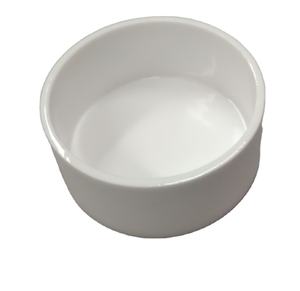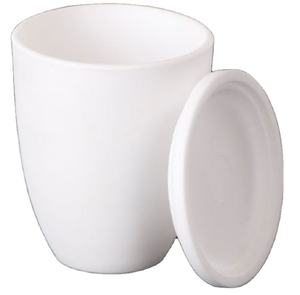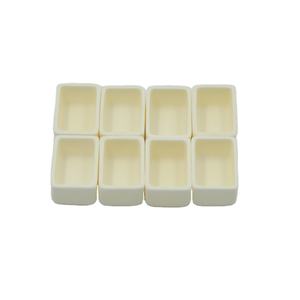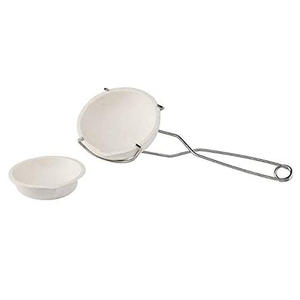Professional industry ceramic supplier, silicon nitride, silicon carbide, aluminum nitride and any other kinds of ceramics.
PRODUCT PARAMETERS
Description
Overview of Industrial Ceramic Crucible for Metal Melting and Casting
Industrial Ceramic Crucible for Metal Melting and Casting are specialized containers designed for withstanding extremely high temperatures in laboratory and industrial settings. They are essential for processes such as melting, calcining, and heat-treating a wide variety of materials, including metals, glasses, and chemicals. Our crucibles are engineered for superior thermal stability and chemical resistance, ensuring purity and reliability in the most demanding applications.
Features of Industrial Ceramic Crucible for Metal Melting and Casting
-
Exceptional Thermal Shock Resistance: Withstands rapid temperature changes without cracking, ensuring durability and a long service life.
-
High-Temperature Stability: Maintains structural integrity at extreme temperatures, often exceeding 1500°C.
-
Excellent Chemical Inertness: Resists corrosion and reaction with molten metals, acids, and aggressive chemical fluxes.
-
High Purity & Low Contamination: Manufactured from premium materials to prevent sample contamination during sensitive processes.
-
Optimized Thermal Properties: Designed for efficient heat transfer and consistent performance in furnace environments.
-
Robust Mechanical Strength: Offers good resistance to physical impact and abrasion during handling and use.
Specifications of Industrial Ceramic Crucible for Metal Melting and Casting
Industrial ceramic crucibles handle high heat for melting metals. These crucibles need strong specifications. The material matters most. Alumina ceramics work well for many metals. Zirconia ceramics handle even tougher jobs. These materials resist extreme temperatures. Crucibles must survive repeated heating cycles. Good thermal shock resistance prevents cracking. This means going from hot to cool safely. Chemical resistance is vital too. The crucible should not react with molten metal. This keeps the metal pure. It also makes the crucible last longer.
Temperature rating is a key specification. Always check the maximum continuous use temperature. Never exceed this limit. It ensures safe operation. The crucible’s purity level affects performance. Higher purity alumina offers better resistance. Crucible wall thickness impacts heat transfer. Thicker walls offer more durability. Thinner walls heat up quicker. Crucible size and shape are important. They must fit your furnace or oven. They also need to hold the required metal volume.
Durability is crucial. A long-lasting crucible saves money. Look for crucibles designed for many melts. Good design helps prevent damage. Smooth inner surfaces are easier to clean. Reinforced rims add strength. Crucible lids are sometimes needed. They help control the melt environment. Choosing the right crucible requires checking all specs. Match the crucible to your specific metal and process. This ensures safety and good results.
Applications of Industrial Ceramic Crucible for Metal Melting and Casting
Industrial ceramic crucibles are essential tools for melting metal. These tough containers handle crazy heat without cracking. That makes them perfect for foundries and metalworking shops. You need reliable equipment when dealing with molten metal. Ceramic crucibles deliver.
Aluminum is a common metal melted in these crucibles. They work great for copper and brass too. Crucibles handle the high temperatures needed to melt these materials. The ceramic won’t react with the molten metal. This keeps your melt pure.
Pouring the melted metal into molds is the next step. Crucibles make this straightforward. They let you pour directly into sand castings. You can also use them for gravity casting setups. The ceramic material doesn’t add impurities. Your cast parts come out cleaner.
Sometimes you need to melt precious metals. Gold and silver melting often uses ceramic crucibles. Platinum group metals require them too. These crucibles withstand the intense heat. They don’t contaminate these valuable materials. Jewelers and specialty metal producers rely on them.
Alloy creation happens inside these crucibles. You can mix different metals together. The crucible holds everything stable at high temperatures. This lets you create custom alloys with precise compositions. The crucible is your mixing pot for molten metal.
Company Profile
Tanki New Materials Co.Ltd. focus on the research and development, production and sales of ceramic products, serving the electronics, ceramics, chemical and other industries. Since its establishment in 2015, the company has been committed to providing customers with the best products and services, and has become a leader in the industry through continuous technological innovation and strict quality management.
Our products includes but not limited to Aerogel, Aluminum Nitride, Aluminum Oxide, Boron Carbide, Boron Nitride, Ceramic Crucible, Ceramic Fiber, Quartz Product, Refractory Material, Silicon Carbide, Silicon Nitride, ect. please feel free to contact us.

Payment Methods
T/T, Western Union, Paypal, Credit Card etc.
Shipment Methods
By air, by sea, by express, as customers request.
5 FAQs of Industrial Ceramic Crucible for Metal Melting and Casting
Industrial ceramic crucibles are vital tools for melting metals. People often ask about them. Here are five common questions.
What exactly is an industrial ceramic crucible? It is a container made from special heat-resistant ceramics. It holds molten metal safely. Crucibles come in different sizes and shapes. They fit various melting furnaces. The material withstands extreme heat. It handles metals like aluminum, copper, and precious alloys.
Why choose ceramic over graphite or metal? Ceramic crucibles resist chemical reactions better. Molten metal won’t easily stick to the surface. This makes pouring cleaner. Ceramics also handle thermal shock well. They don’t crack as fast when temperatures change quickly. They offer good value for many foundry jobs.
What temperature can these crucibles handle? The maximum temperature depends on the ceramic type. Common clay-graphite crucibles work up to about 1300°C. Higher purity alumina or silicon carbide types can go much hotter. Always check the manufacturer’s rating for your specific crucible. Never exceed the stated limit. Overheating damages the crucible fast.
How long will a ceramic crucible last? Crucible life varies a lot. It depends on the metal melted, the temperature used, and how you handle it. Careful use makes it last longer. Avoid rough handling or sudden temperature shifts. Inspect it before each use. Look for cracks or deep wear. Replace it when it shows significant damage. Safety is crucial.
Are there special safety steps for ceramic crucibles? Yes. Always preheat a new crucible slowly. This drives out any moisture. Moisture causes explosions when heated fast. Wear protective gear. Handle hot crucibles only with proper tools. Let the crucible cool completely before cleaning or moving it. Follow all safety instructions from the crucible maker.
REQUEST A QUOTE
RELATED PRODUCTS

Hot 99.99% High Purity Gold Melting Graphite Ceramic Crucible for Jewelry Industry

Making a Refractory Custom High Temperature Alumina Ceramic Corundum Crucible for Furnace Kiln

99% Alumina Ceramic Crucible for Refractory Industry

High Heat Resistant 95% Alumina 99% Alumina Ceramic Crucible

Customized Whole High Quality TIB2 Ceramic Thermal Shock Resistance Molten Meta Titanium Diboride Crucible



